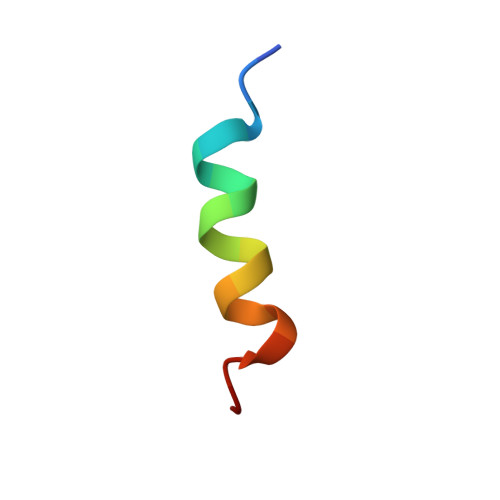Two peptide fragments G55-I72 and K97-A109 from staphylococcal nuclease exhibit different behaviors in conformational preferences for helix formation
Wang, M., Shan, L., Wang, J.F.(2006) Biopolymers 83: 268-279
- PubMed: 16767771
- DOI: https://doi.org/10.1002/bip.20558
- Primary Citation of Related Structures:
2FXY, 2FXZ - PubMed Abstract:
Two synthetic peptides, SNasealpha1 and SNasealpha2, corresponding to residues G55-I72 and K97-A109, respectively, of staphylococcal nuclease (SNase), are adopted for detecting the role of helix alpha1 (E57-A69) and helix alpha2 (M98-Q106) in the initiation of folding of SNase. The helix-forming tendencies of the two SNase peptide fragments are investigated using circular dichroism (CD) and two-dimensional (2D) nuclear magnetic resonance (NMR) methods in water and 40% trifluoroethanol (TFE) solutions. The coil-helix conformational transitions of the two peptides in the TFE-H2O mixture are different from each other. SNasealpha1 adopts a low population of localized helical conformation in water, and shows a gradual transition to helical conformation with increasing concentrations of TFE. SNasealpha2 is essentially unstructured in water, but undergoes a cooperative transition to a predominantly helical conformation at high TFE concentrations. Using the NMR data obtained in the presence of 40% TFE, an ensemble of alpha-helical structures has been calculated for both peptides in the absence of tertiary interactions. Analysis of all the experimental data available indicates that formation of ordered alpha-helical structures in the segments E57-A69 and M98-Q106 of SNase may require nonlocal interactions through transient contact with hydrophobic residues in other parts of the protein to stabilize the helical conformations in the folding. The folding of helix alpha1 is supposed to be effective in initiating protein folding. The formation of helix alpha2 depends strongly on the hydrophobic environment created in the protein folding, and is more important in the stabilization of the tertiary conformation of SNase.
- National Laboratory of Biomacromolecules, Institute of Biophysics, Chinese Academy of Sciences, 15 Datun Road, Beijing 100101, People's Republic of China.
Organizational Affiliation:
















